Reviews
This Year’s Turner Prize Show Is a Remarkably Satisfying Exhibition, Thanks to More Mature Artists
In an edition which boasts a strong, politically engaged line-up, Lubaina Himid stands out as a favourite.
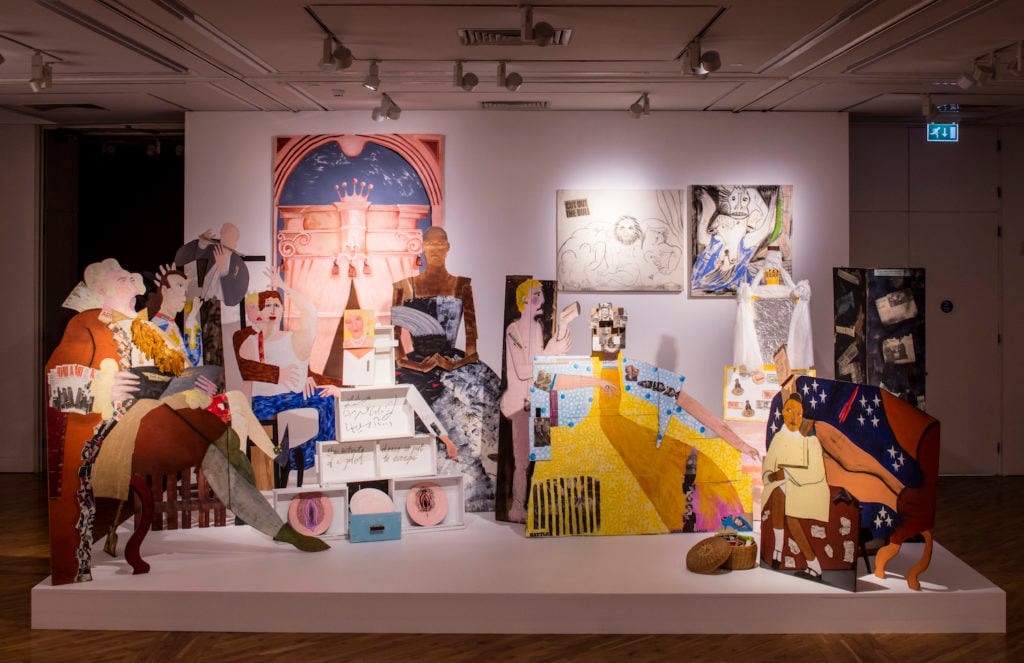
In an edition which boasts a strong, politically engaged line-up, Lubaina Himid stands out as a favourite.

Hettie Judah

The politics of representation emerges as the dominant theme of a Turner Prize show in which four artists’ works coalesce into a remarkably satisfying exhibition.
This year’s shortlist—Andrea Büttner, Rosalind Nashashibi, Hurvin Anderson, and Lubaina Himid—provoked comment at its announcement: for the lifting of the prize’s age limit, for the diversity of the nominees, and for the artists’ engagement with traditional media, including painting and printmaking.
An unexpected side effect of embracing works by more mature artists is Lubaina Himid’s decision to show A Fashionable Marriage, made in 1986. Displayed alongside two more recent series—the recontextualised crockery of Swallow Hard: The Lancaster Dinner Service (2007) and graphic newspaper interventions of Negative Positives: The Guardian Archive (2007–15)—it emphasized the artist’s consistency of voice and vision, as well as the enduring timeliness of her themes.
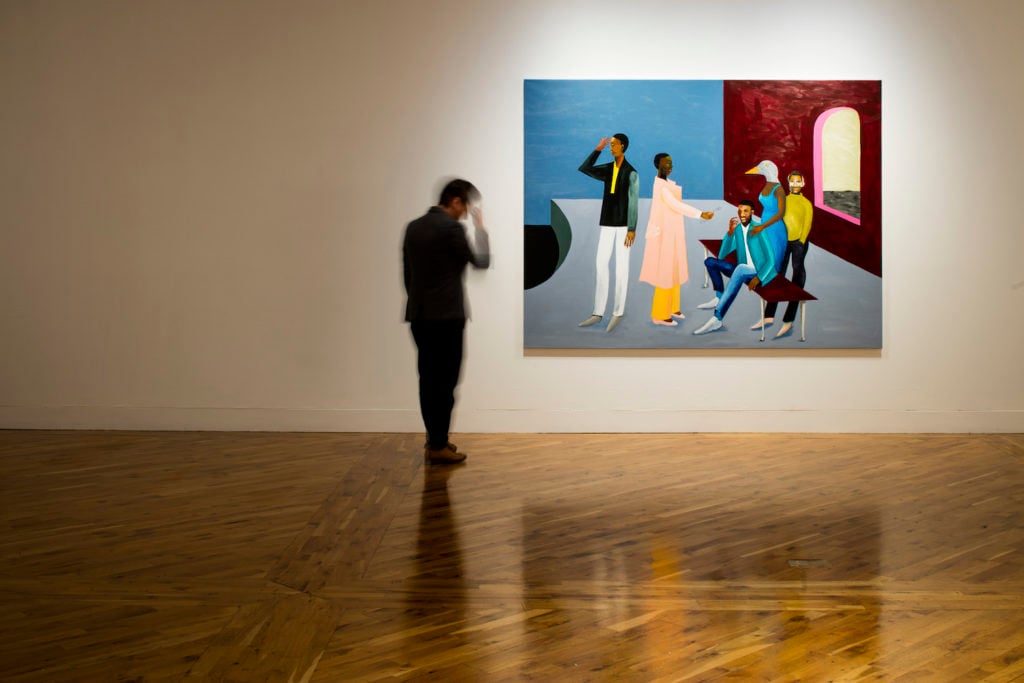
Lubaina Himid, Le Rodeur: The Exchange (2016) at the Turner Prize 2017 exhibition, Ferens Art Gallery Hull. Loaned from Hollybush Gardens. Photo David Levene.
Shown earlier this year as part of the historical survey “The Place Is Here” at Nottingham Contemporary, A Fashionable Marriage recasts Hogarth’s Marriage à la Mode (1743). The figures of Margaret Thatcher and Ronald Reagan here occupy the roles of the Countess and amorous lawyer Silvertongue. The marginal figures of the African servants are recast as Black women embodying virtues of wisdom and grace. Presented as a series of life-sized cutouts, decorated with collage relating to current events, the work also suggests Himid’s identification with female artists of the time: two plates tumbling from the dresser are decorated with stylised labia that recall Judy Chicago’s The Dinner Party (1974–79).
Himid’s display is remarkably strong, and one might put the smart money on her as the eventual laureate. Were it to go her way, the prize would also be an acknowledgement of her important role as a curator and archivist.
Andrea Büttner, an artist who has historically explored issues of authorship, has also chosen to extend herself into a quasi-curatorial role by hosting a display on the ideas of Simone Weil, on loan from the Peace Library and Antiwar Museum of the Evangelical Church of Berlin. While there were strong works and series within her exhibition, Büttner’s work overall sat a little uncomfortably.
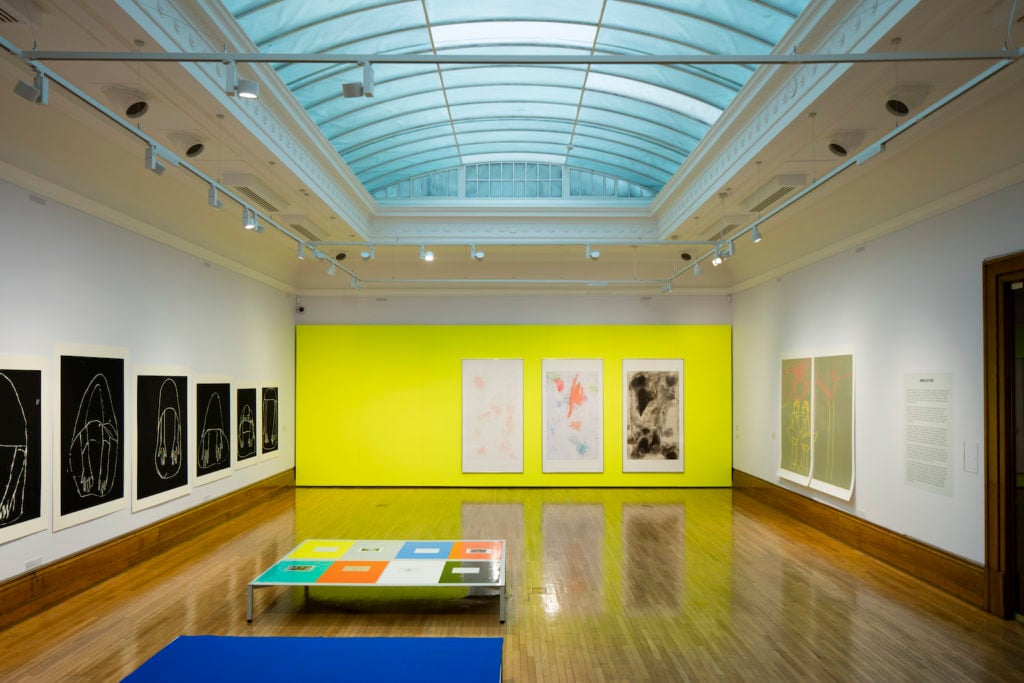
Installation view of Andrea Büttner’s work at the Turner Prize 2017 exhibition, Ferens Art Gallery Hull. Photo David Levene.
A series of large etchings made of fingerprint smears left on smartphone screens—a physically demanding and highly skilled response to involuntary mark making—were a highlight. Büttner’s ongoing interest in condescension and oversight was represented here in woodcuts showing hooded beggars seen from above, their forms reduced to anonymity that bordered on abstraction. A series of prints of historic etchings of begging figures are shown at a low table, forcing one to look down.
While one can appreciate the humility of the gesture, the inclusion of the Simone Weil display upsets the balance of Büttner’s own work, its text demanding our time and attention. The suggestion of timeliness implicit in Weil’s writing—on the rise of fascist powers and the danger of uprootedness caused by conflict and economic forces—feels reductive.
Works by Rosalind Nashashibi and Hurvin Anderson introduce a quality not often associated with the Turner Prize: beauty. It is a quality Nashashibi seeks out—and finds—in Electrical Gaza (2015) an alternative representation of a location commonly pictured in the context of crisis and conflict. Nashashibi brings it an almost magical realist quality: we see boys cooling off with festively adorned horses in the sea; soft, almost sensual conversation and song shared by a group of young men; and a pavement fish market that recalls a Joachim Beuckelaer painting on display in a neighbouring gallery. Portions of the film that the artist was unable to finish shooting because of mounting threat are rendered in animation, and a sense of non-specific tension flashes unexpectedly into the work as it ends.
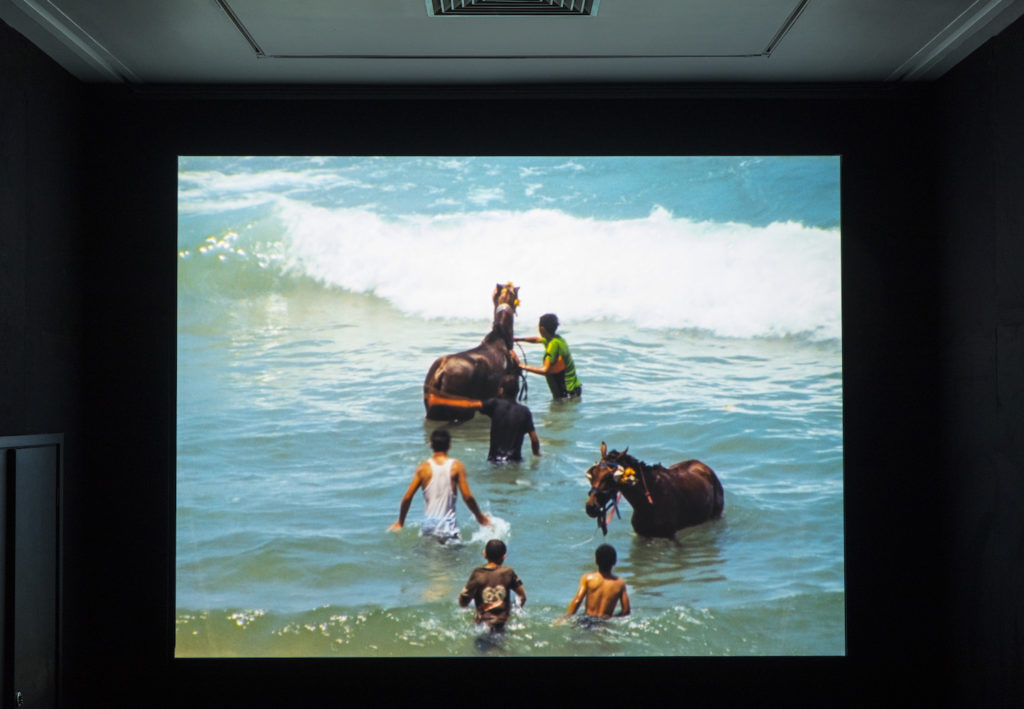
Installation view of Rosalind Nashashibi’s work at the Turner Prize 2017 exhibition, Ferens Art Gallery Hull. Photo David Levene.
A second film by Nashashibi, Vivian’s Garden (2017) is set in the Guatemalan home of artists Vivian Suter and her mother Elisabeth Wild. Themes of caregiving and making emerge as the camera roves between mother and daughter, the servants that tend them and a group of dogs with which they share the complex. At the heart is the titular garden, a wild and tropical presence that provides Suter with the site, subject and often material for her work. The dark green of monstera leaves, terracotta walls and eau de Nil drapes set off Suter’s flame-red hair as she makes her way through this painterly and gorgeously coloured piece of filmmaking.
That sensitivity to colour is extended in Hurvin Anderson’s lusciously verdant arboreal paintings, one of two bodies of works by the artist that are likely candidates for the popular vote. Anderson’s paint handling is delectable, with images that build in structural drama through impasto, strong colour, and crisp line before dissolving into washy stain at the edges. In Greensleeves (2017) patches of a figure appear through the tree branches toward the upper left of the canvas, but as we move away from this focal point Anderson fragments the image so far that we can see the grid points with which he plotted the composition.
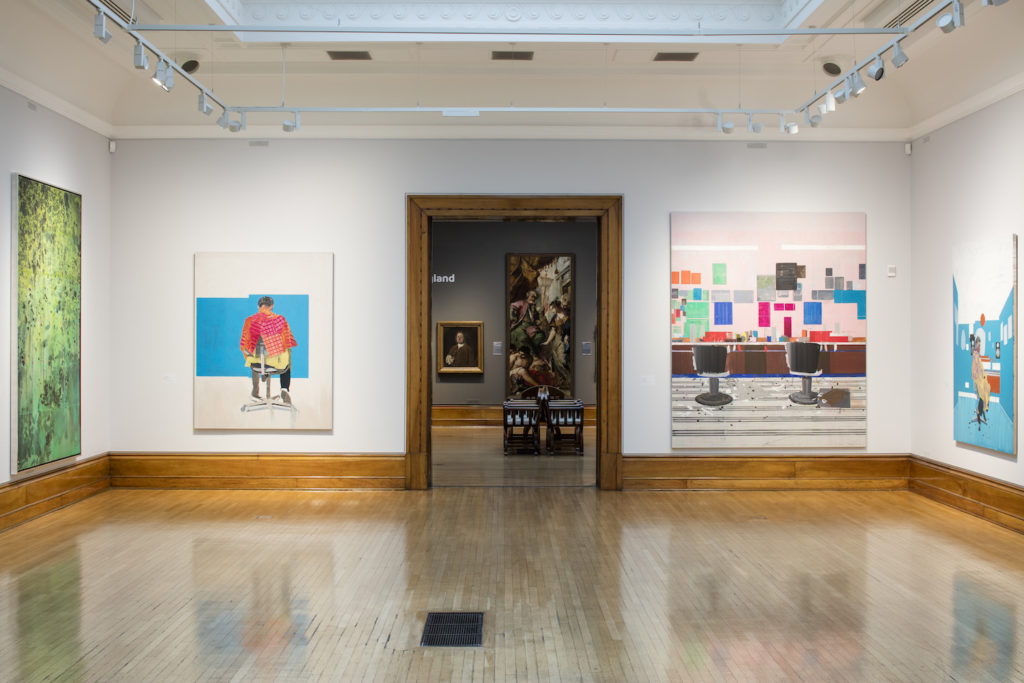
Installation view of Hurvin Anderson’s work at the Turner Prize 2017 exhibition, Ferens Art Gallery Hull. Photo David Levene.
Four earlier works set in barbershops explore problematics of portraiture. Two, from the series Peter’s Sitters (2009) offer faceless men, sitting not for the artist but for the barber, who will in his own way create a fresh portrait of them: a new self with a new haircut. Anderson takes this question of projected self-image a step further in Is It OK to Be Black? (2016), in which the haircut display board has been repopulated by images of Malcolm X, Nelson Mandela, and Martin Luther King.
This is likely to be a popular year for the Turner Prize. In shifting the focus to artists at a more mature stage in their careers, some of whom have pointedly engaged with audiences beyond the artworld elite, this year’s shortlist has a clarity of vision and voice that makes their works particularly engaging.
The Turner Prize 2017 exhibition is on show at the Ferens Art Gallery, Hull, September 26, 2017–January 7, 2018. The winner will be announced on December 5 at an award ceremony in Hull, broadcast live on the BBC.